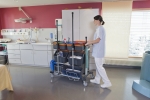Issue Date: 4 June 2014
Ref: DIV13/43
Delivering Consistency For Hospital Cleaning
By Katie Pett, Health Sector Marketing Manager, Diversey Care
While there are some interesting differences in hospital cleaning and hygiene processes around Europe the lack of consistency within individual countries remains a bigger barrier to improving standards and compliance. What is needed is a framework that can benchmark performance, define agreed processes and measure improvement.
In most hospitals the floors form a large proportion of the area being cleaned. Yet while effective cleaning is important to maintain a good appearance and reduce the risk of slips and trips, floors generally represent a relatively low risk when it comes to the spread of infections. It is far more important to focus attention on frequent touch surfaces such as door knobs, light switches, bedside tables, bed frames and equipment because these are where infections can linger and spread the easiest. Regular and frequent cleaning of these “hot spots” is one of the most significant ways to prevent the spread of infections.
Approaches to these challenges differ in countries around Europe even if the desired result is the same. In the Netherlands, for example, housekeepers typically use conventional cleaning products with the aim of removing all sources of contamination, although disinfectants are still used for some processes. The opposite tends to be the case in Germany and France where the emphasis is more on disinfection. Many institutions in the UK take a “belt and braces” approach using combined cleaner-disinfectants for daily cleaning. The logic is that while the cleaner will remove the contamination the disinfectant will kill any remaining pathogens. This has the added benefit of simplifying the process because one product is used instead of two which can reduce training, labour and supply chain costs.
Until recently the disinfectants of choice in many countries have been chlorine or quat based and these are still widely used when outbreaks occur. New formulations containing hydrogen peroxide as the active ingredient have recently been developed and are increasingly popular in Nordic countries amongst others. These offer new capabilities, are suitable for many fabrics as well as hard surfaces, are effective against a wide range of pathogens, and are safe to use. Products like this are available in the UK but have not yet been widely adopted by the NHS.
The lesson is that no one way is right. Cultural, historical and political factors can all lead to differences in approach in each country. Cleaning product suppliers are not in a position to dictate how any particular institution will clean, and nor should they. Hospitals must choose the processes and products that are right for their unique circumstances. But reputable suppliers such as Diversey Care will be able to provide advice on the right products, tools and equipment to support the processes needed to achieve the best and most cost effective results. So much the better if they have a wide range of products supported with verified data to back up any infection prevention claims.
No matter how good the product or process it will make little difference if it is not used correctly. In practice, gaps in cleaning compliance often arise when staff do not appreciate their responsibilities or do not know the most suitable products and how they should be applied. Understanding that an item of equipment should be cleaned is quite different to knowing how it should be done correctly or who will do it, the housekeepers or the nurses. Sadly there is little consistency across geographies or even within individual countries which leads to variations in outcomes.
Paradoxically, while cleaning plays an undoubtedly major role protecting and saving lives by preventing infections it is typically undertaken by people who are among the least well paid, have very low status and often do not fully appreciate - because of education or language barriers - the significance of what they do. In an ideal world these “hidden heroes” would be better trained, valued and supported.
To achieve greater consistency and make incremental improvements in standards hospitals ideally need a framework that helps them devise, verify and validate their cleaning processes and staff training with the requisite level of detail to benchmark and measure performance and compliance. Only then can decisions be evidence based and processes developed that support and deliver the desired objectives. Cleaning companies can help by providing the knowledge, support and technical expertise based on their experience with different customers in different countries to help drive best practice more consistently.

